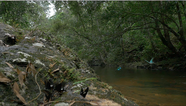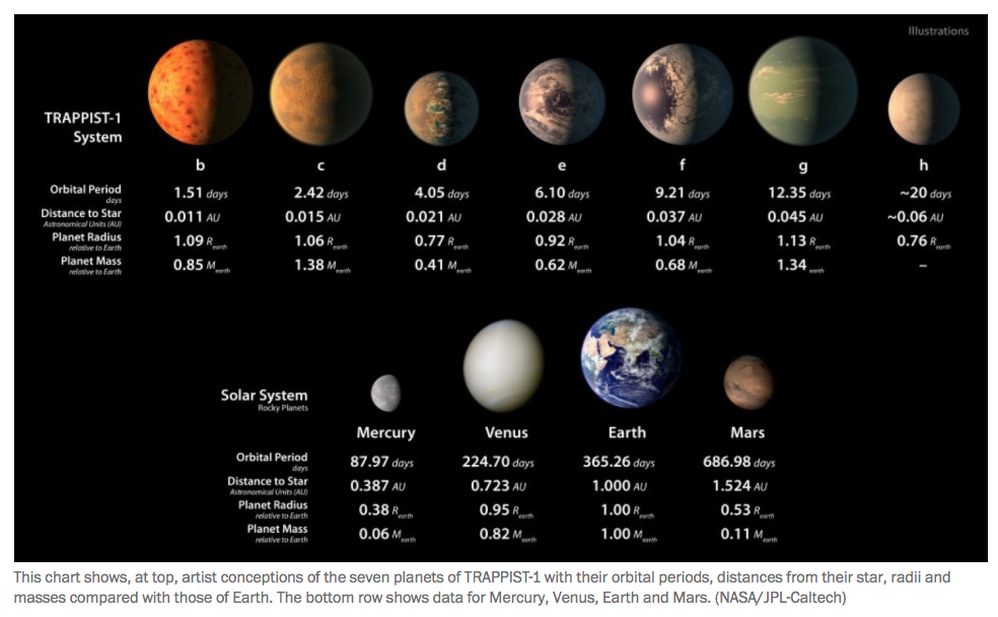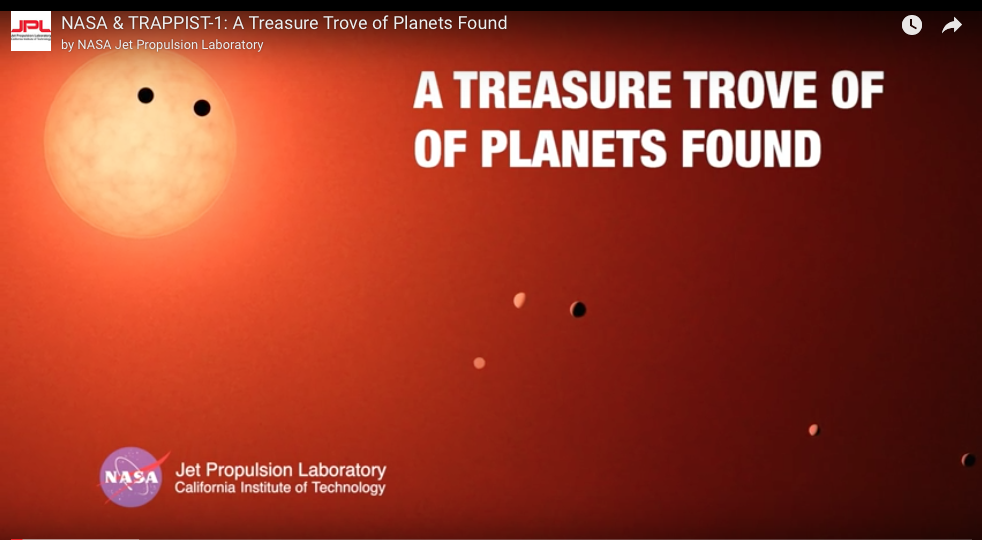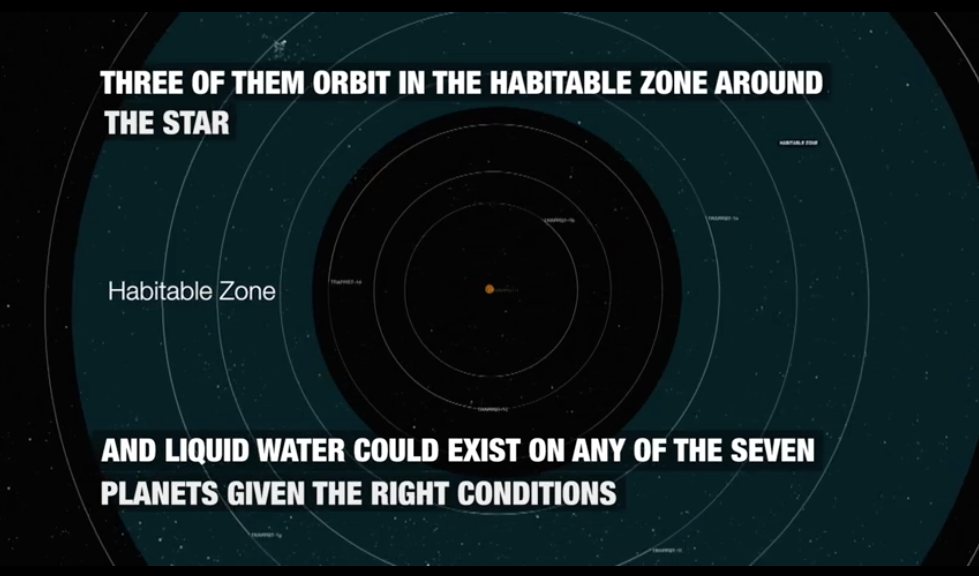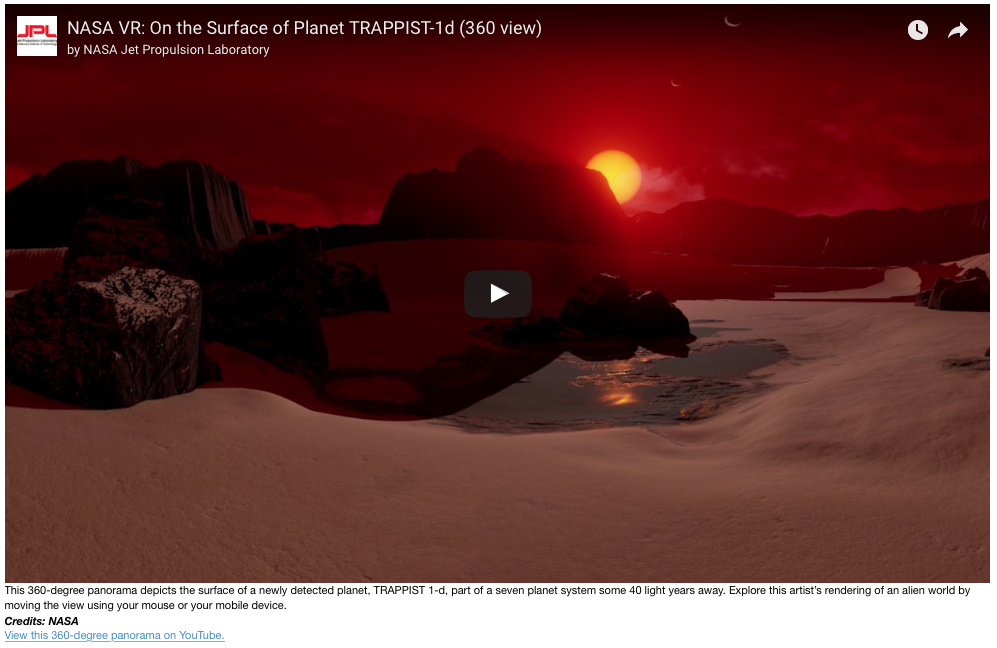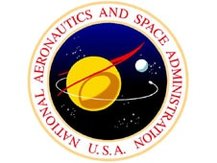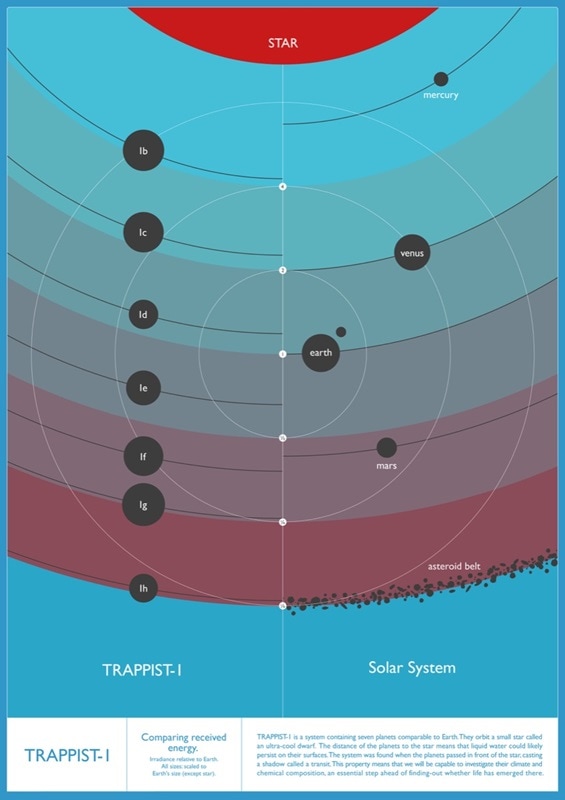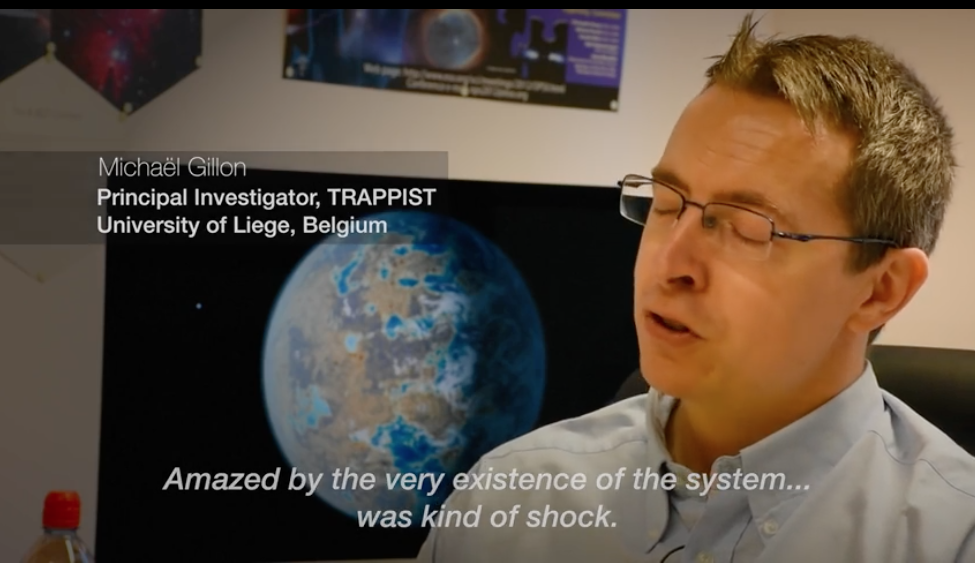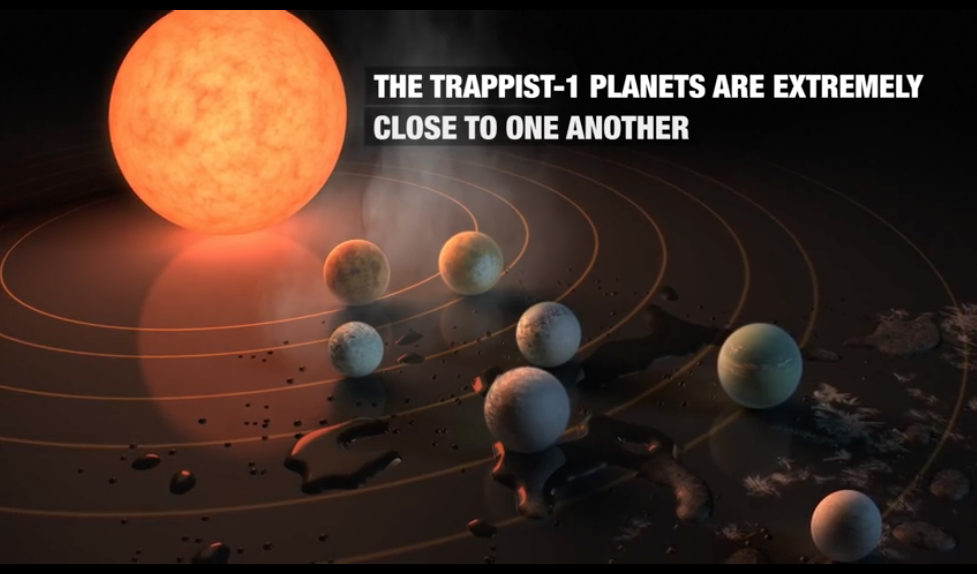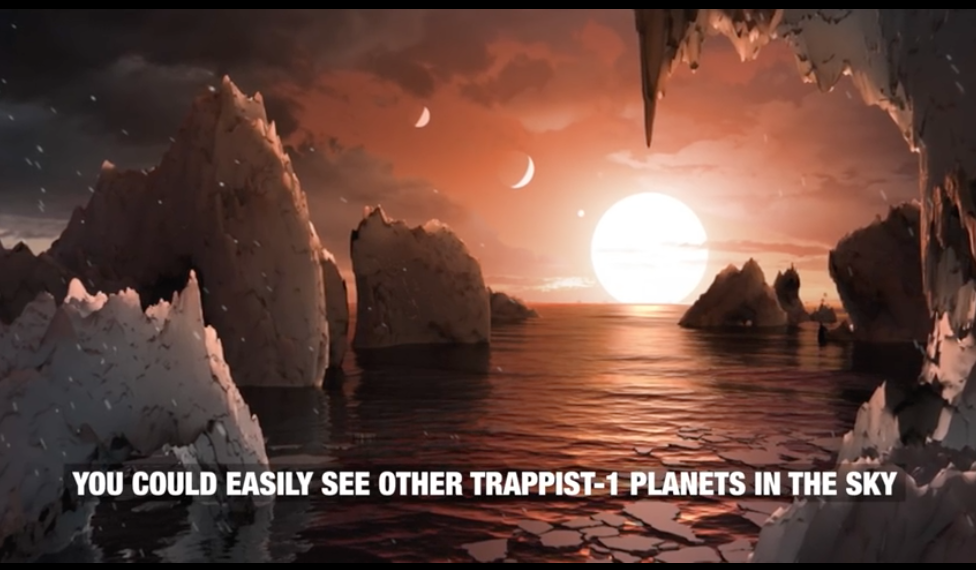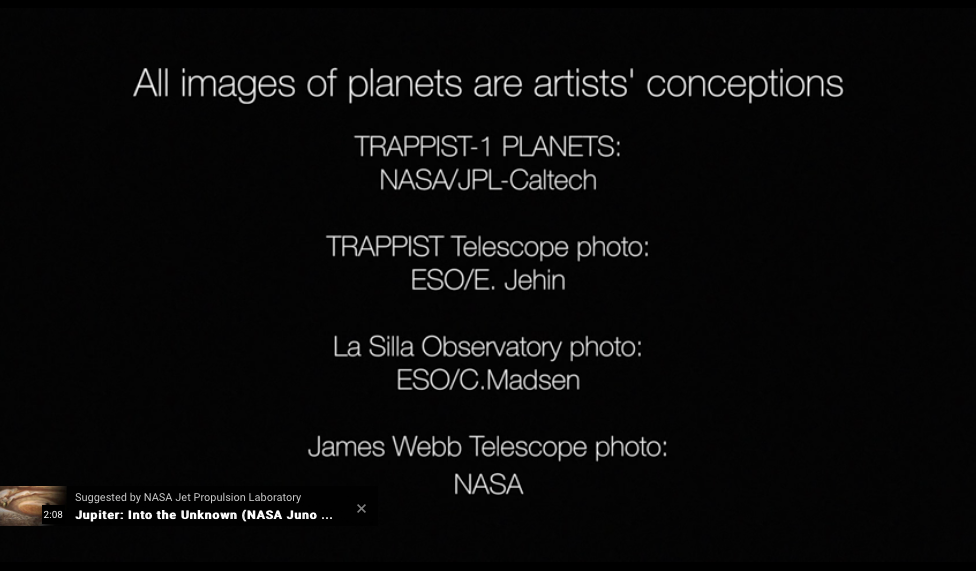|
Astronomers found a new solar system just 39 light years from ours, full of Earthlike planets. Here’s what you should know about the TRAPPIST-1 system. (Jenny Starrs, Sarah Kaplan/The Washington Post)
Speaking of Science
Scientists discover 7 ‘Earthlike’ planets orbiting a nearby star By Sarah Kaplan February 22 at 1:00 PM 5 A newfound solar system just 39 light-years away contains seven warm, rocky planets, scientists say. The discovery, reported Wednesday in the journal Nature, represents the first time astronomers have detected so many terrestrial planets orbiting a single star. Researchers say the system is an ideal laboratory for studying distant worlds and could be the best place in the galaxy to search for life beyond Earth. “Before this, if you wanted to study terrestrial planets, we had only four of them and they were all in our solar system,” said lead author Michaël Gillon, an exoplanet researcher at the University of Liege in Belgium. “Now we have seven Earth-sized planets to expand our understanding. Yes, we have the possibility to find water and life. But even if we don't, whatever we find will be super-interesting.” The newly discovered solar system resembles a scaled-down version of our own. The star at its center, an ultra-cool dwarf called TRAPPIST-1, is less than a tenth the size of our sun and about a quarter as warm. Its planets circle tightly around it; the closest takes just a day and a half to complete an orbit and the most distant takes about 20 days. If these planets orbited a larger, brighter star they would be fried to a crisp. But TRAPPIST-1 is so cool that all seven of the bodies are bathed in just the right amount of warmth to hold liquid water. And three of them receive the same amount of heat as Venus, Earth and Mars, putting them in “the habitable zone,” that Goldilocks region where it's thought life can thrive. The researchers call these worlds “Earthlike,” though it’s a generous term. The planets of the TRAPPIST-1 system do resemble Earth in terms of size, mass and the energy they receive from their star, but there's a lot that makes our planet livable besides being a warm rock. Further observation is required to determine the composition of the TRAPPIST-1 bodies, if they have atmospheres and if they hold water, methane, oxygen and carbon dioxide — the molecules that scientists consider “biosignatures,” or signs of life. “You can bet people will be rushing to take those measurements,” said Elisabeth Adams, an exoplanet researcher at the Planetary Science Institute who was not involved in the study. “That's going to be fascinating to see.” Whatever secrets it may harbor, the TRAPPIST-1 system would surely be a sight to behold. Though the star is small, its nearness to the planets means that, from their perspective, it appears about three times as large as our sun. The outermost planets enjoy the daily spectacle of their neighbors passing across the sky and in front of their shared sun, each world a large dark spot silhouetted against the salmon-colored star. Its dim glow, which skews toward the red and infrared end of the light spectrum, bathes the planets in warmth and paints their skies with the crimson hues of a perpetual sunset. Gillon and his colleagues have been interested in TRAPPIST-1 since late 2015. Using the European Southern Observatory's Transiting Planets and Planetesimals Small Telescope (TRAPPIST) in Chile, they sensed small dips in the star's brightness at regular intervals. These dips were caused by planets transiting — crossing between the star and Earth — and blocking some of its light. Last May, the scientists published their discovery in Nature: three rocky bodies, dubbed TRAPPIST-1b, -1c and -1d, orbited the small star, they said. But right around the time the study was published, Gillon noticed that TRAPPIST-1d was behaving oddly. When he went to get a closer look with the Very Large Telescope, the ESO's gigantic observatory in South America's Atacama Desert, he realized that the dip in brightness he thought came from 1d was actually caused by three planets, all transiting at the same time. This happens only once every three years, said Julien de Wit, a planetary scientist at the Massachusetts Institute of Technology and a co-author on the study. “The chance of catching it is less than one in a thousand,” he explained. “It's funny because it’s such a huge paper with amazing results, and we got it from sheer luck.” Next the team hurried to request time at the Spitzer Space Telescope, whose Earth-trailing orbit around the sun offered an uninterrupted view of TRAPPIST-1 and its companions. During 20 days with the Spitzer telescope, the team witnessed 34 transits. These observations “lifted the veil on the architecture of the system,” as de Wit put it. Instead of three planets, TRAPPIST-1 had seven, renamed TRAPPIST-1b through -h in order of their distance from the star. This chart shows, at top, artist conceptions of the seven planets of TRAPPIST-1 with their orbital periods, distances from their star, radii and masses compared with those of Earth. The bottom row shows data for Mercury, Venus, Earth and Mars. (NASA/JPL-Caltech)
The scientists determined that the six inner planets are locked in an orbital resonance, meaning that the lengths of their orbits are related by a ratio of whole numbers. Because of this, the bodies exert regular gravitational influences on one another. By measuring those influences, the astronomers could determine the mass of the planets, something that is impossible to figure out from transiting data alone. That in turn allowed them to loosely calculate their densities — giving a sense of how much iron, rock, water and gas the bodies contain.
The fact the planets are in orbital resonance also suggests that they formed farther out from their sun and then migrated inward, Gillon said. This makes it more likely that they will contain water in some form, since water and other volatile compounds (molecules that readily turn to gas) tend to concentrate on the outer edges of solar systems. Coincidentally, TRAPPIST-1 is in the constellation Aquarius — the water-bearer. For years, evidence has accumulated that the Milky Way galaxy is full of Earthlike planets. The discovery of seven such worlds around a single, faint star suggests that they may be even more common than originally thought. Three planets of the TRAPPIST-1 system resemble Earth in terms of size, mass, and the energy they receive from their star. (Reuters) Gillon and his colleagues plan to seek out similar solar systems with a new project, Search for Habitable Planets Eclipsing Ultracool Stars, or SPECULOOS. (Like Trappist beer, speculoos cookies are a Belgian delicacy. His next effort will have to be called WAFFLES.) Meanwhile, scientists are scrambling to get a better look at Proxima b, a rocky world that was discoveredorbiting our sun's nearest neighbor, Proxima Centauri, last August. But the TRAPPIST-1 researchers, along with several astronomers not involved with the study, say this system is our best target yet to search for extraterrestrial life. Though exoplanet scientists often focus on worlds orbiting sunlike stars, the brightness of those stars makes it difficult to spot small, rocky planets. TRAPPIST-1's planets are easy to find amid its dim, cool glow. The system is also incredibly close to Earth. Though 39 light-years would be a long way for humans to travel, it's practically next door when you consider that the Milky Way galaxy alone is 100,000 light-years across. The closeness of TRAPPIST-1 puts it within the reach of the James Webb Space Telescope, which will be able to detect atmospheric components and thermal emissions from the planets after it launches in 2018. In the meantime, telescopes on several continents have been trained on the system to search for signs of life. Last summer, the scientists published an early analysis of the atmospheres of planets b and c using data from the Hubble Space Telescope. “This is direct exploration of another solar system that is happening right now,” Gillon said. Planets e, f and g are the most intriguing targets for astrobiologists because of their position in TRAPPIST-1's habitable zone. But even if they turn out to be warm and wet, these worlds might not be great places to live. The planets' proximity to the star and one another means that they are probably tidally locked, like Earth's moon. One side of each planet always faces the sun; the other is stuck in constant darkness. This would make for a dramatic temperature gradient that could generate powerful winds — not exactly an earthling's idea of a cozy home. And Adams, of the Planetary Science Institute, cautioned that it's very hard to tell whether a planet is habitable from a distance. An observer outside our solar system might look at Venus, Earth and Mars and reason that the sun hosts three habitable worlds. The alien would need to travel here in person to discover that Venus is a cloudy hell-scape with a runaway greenhouse effect, while Mars is a barren, frozen desert with a defunct internal dynamo. “There are a lot of ways in which a planet could be like Earth, but not enough,” Adams said. Another major caveat, she added, is that the very idea of a “habitable world” is purely theoretical. Scientists have only one source of data on habitable planets, and that's Earth. “We don’t actually know the parameters that are needed for life on another world,” Adams said, “how much it has to look exactly like Earth and how different life could be elsewhere.” Still, even if no life is discovered on them, the TRAPPIST-1 planets present an unprecedented new window on how solar systems work. Though the planets are more or less Earth-size, their varying densities and distances allow for detailed comparisons of the worlds. It's almost as if someone designed an experiment in planet formation, controlling for the bodies' size. De Wit compared the new planets to seven new languages, each offering a new vocabulary for describing its corner of the universe. “They all have a slightly different perspective on the same story,” he said, “the story of this solar system.” --------------------------------- The Washington Post: https://www.washingtonpost.com/news/speaking-of-science/wp/2017/02/22/scientists-discover-seven-earthlike-planets-orbiting-a-nearby-star/?hpid=hp_hp-top-table-main_no-name%3Ahomepage%2Fstory&utm_term=.82fdecf6c968 Trappist beer ของเบลเยี่ยม https://en.wikipedia.org/wiki/Trappist_beer Speculoos เป็นขนมคุ๊กกี้กินแกล้มกับเบียร์ https://belgianbeershrimper.wordpress.com/tag/speculoos/ ขนมวัฟเฟิ้ล (waffle) มีต้นกำเนิดจากประเทศเบลเยี่ยม http://www.huffingtonpost.com/2015/02/02/belgian-waffles-history_n_6535434.html อ้างอิง:
The Washington Post: https://www.washingtonpost.com/news/speaking-of-science/wp/2017/02/22/scientists-discover-seven-earthlike-planets-orbiting-a-nearby-star/?hpid=hp_hp-top-table-main_no-name%3Ahomepage%2Fstory&utm_term=.82fdecf6c968 Trappist beer ของเบลเยี่ยม https://en.wikipedia.org/wiki/Trappist_beer Speculoos เป็นขนมคุ๊กกี้กินแกล้มกับเบียร์ https://belgianbeershrimper.wordpress.com/tag/speculoos/ ขนมวัฟเฟิ้ล (waffle) มีต้นกำเนิดจากประเทศเบลเยี่ยม http://www.huffingtonpost.com/2015/02/02/belgian-waffles-history_n_6535434.html 
This illustration shows the possible surface of TRAPPIST-1f, one of the newly discovered planets in the TRAPPIST-1 system. Scientists using the Spitzer Space Telescope and ground-based telescopes have discovered that there are seven Earth-size planets in the system.
Credits: NASA/JPL-Caltech
View this and many more images, as well as several videos, in an extensive
multimedia gallery highlighting this discovery.

Exoplanets
Feb. 23, 2017 RELEASE 17-015 NASA Telescope Reveals Largest Batch of Earth-Size, Habitable-Zone Planets Around Single Star NASA's Spitzer Space Telescope has revealed the first known system of seven Earth-size planets around a single star. Three of these planets are firmly located in the habitable zone, the area around the parent star where a rocky planet is most likely to have liquid water. The discovery sets a new record for greatest number of habitable-zone planets found around a single star outside our solar system. All of these seven planets could have liquid water – key to life as we know it – under the right atmospheric conditions, but the chances are highest with the three in the habitable zone. “This discovery could be a significant piece in the puzzle of finding habitable environments, places that are conducive to life,” said Thomas Zurbuchen, associate administrator of the agency’s Science Mission Directorate in Washington. “Answering the question ‘are we alone’ is a top science priority and finding so many planets like these for the first time in the habitable zone is a remarkable step forward toward that goal.” At about 40 light-years (235 trillion miles) from Earth, the system of planets is relatively close to us, in the constellation Aquarius. Because they are located outside of our solar system, these planets are scientifically known as exoplanets
This exoplanet system is called TRAPPIST-1, named for The Transiting Planets and Planetesimals Small Telescope (TRAPPIST) in Chile. In May 2016, researchers using TRAPPIST announced they had discovered three planets in the system. Assisted by several ground-based telescopes, including the European Southern Observatory's Very Large Telescope, Spitzer confirmed the existence of two of these planets and discovered five additional ones, increasing the number of known planets in the system to seven. The new results were published Wednesday in the journal Nature, and announced at a news briefing at NASA Headquarters in Washington. Using Spitzer data, the team precisely measured the sizes of the seven planets and developed first estimates of the masses of six of them, allowing their density to be estimated. Based on their densities, all of the TRAPPIST-1 planets are likely to be rocky. Further observations will not only help determine whether they are rich in water, but also possibly reveal whether any could have liquid water on their surfaces. The mass of the seventh and farthest exoplanet has not yet been estimated – scientists believe it could be an icy, "snowball-like" world, but further observations are needed. "The seven wonders of TRAPPIST-1 are the first Earth-size planets that have been found orbiting this kind of star," said Michael Gillon, lead author of the paper and the principal investigator of the TRAPPIST exoplanet survey at the University of Liege, Belgium. "It is also the best target yet for studying the atmospheres of potentially habitable, Earth-size worlds." The TRAPPIST-1 star, an ultra-cool dwarf, has seven Earth-size planets orbiting it. This artist's concept appeared on the cover of the journal Nature on Feb. 23, 2017.
Credits: NASA/JPL-Caltech View full image and caption This artist's concept shows what each of the TRAPPIST-1 planets may look like, based on available data about their sizes, masses and orbital distances.
Credits: NASA/JPL-Caltech View full image and caption In contrast to our sun, the TRAPPIST-1 star – classified as an ultra-cool dwarf – is so cool that liquid water could survive on planets orbiting very close to it, closer than is possible on planets in our solar system. All seven of the TRAPPIST-1 planetary orbits are closer to their host star than Mercury is to our sun. The planets also are very close to each other. If a person was standing on one of the planet’s surface, they could gaze up and potentially see geological features or clouds of neighboring worlds, which would sometimes appear larger than the moon in Earth's sky.
The planets may also be tidally locked to their star, which means the same side of the planet is always facing the star, therefore each side is either perpetual day or night. This could mean they have weather patterns totally unlike those on Earth, such as strong winds blowing from the day side to the night side, and extreme temperature changes. Spitzer, an infrared telescope that trails Earth as it orbits the sun, was well-suited for studying TRAPPIST-1 because the star glows brightest in infrared light, whose wavelengths are longer than the eye can see. In the fall of 2016, Spitzer observed TRAPPIST-1 nearly continuously for 500 hours. Spitzer is uniquely positioned in its orbit to observe enough crossing – transits – of the planets in front of the host star to reveal the complex architecture of the system. Engineers optimized Spitzer’s ability to observe transiting planets during Spitzer’s “warm mission,” which began after the spacecraft’s coolant ran out as planned after the first five years of operations. "This is the most exciting result I have seen in the 14 years of Spitzer operations," said Sean Carey, manager of NASA's Spitzer Science Center at Caltech/IPAC in Pasadena, California. "Spitzer will follow up in the fall to further refine our understanding of these planets so that the James Webb Space Telescope can follow up. More observations of the system are sure to reveal more secrets.” Following up on the Spitzer discovery, NASA's Hubble Space Telescope has initiated the screening of four of the planets, including the three inside the habitable zone. These observations aim at assessing the presence of puffy, hydrogen-dominated atmospheres, typical for gaseous worlds like Neptune, around these planets. NASA VR: On the Surface of Planet TRAPPIST-1d (360 view)
Published on 22 Feb 2017 This 360-degree panorama depicts the surface of a newly detected planet, TRAPPIST-1d, part of a seven planet system some 40 light years away. You can explore this artist’s rendering of an alien world by moving the view using your mouse or your mobile device. View this 360-degree panorama on YouTube. In May 2016, the Hubble team observed the two innermost planets, and found no evidence for such puffy atmospheres. This strengthened the case that the planets closest to the star are rocky in nature.
"The TRAPPIST-1 system provides one of the best opportunities in the next decade to study the atmospheres around Earth-size planets," said Nikole Lewis, co-leader of the Hubble study and astronomer at the Space Telescope Science Institute in Baltimore, Maryland. NASA's planet-hunting Kepler space telescope also is studying the TRAPPIST-1 system, making measurements of the star's minuscule changes in brightness due to transiting planets. Operating as the K2 mission, the spacecraft's observations will allow astronomers to refine the properties of the known planets, as well as search for additional planets in the system. The K2 observations conclude in early March and will be made available on the public archive. 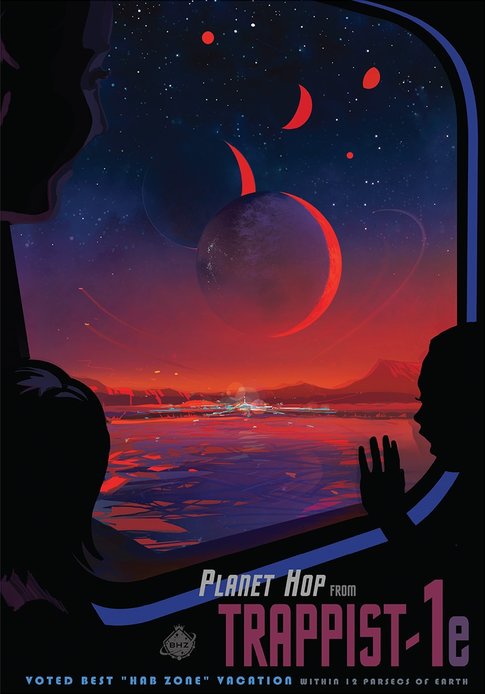
This poster imagines what a trip to TRAPPIST-1e might be like.
Credits: NASA/JPL-Caltech
Some 40 light-years from Earth, a planet called TRAPPIST-1e offers a heart-stopping view: brilliant objects in a red sky, looming like larger and smaller versions of our own moon. But these are no moons. They are other Earth-sized planets in a spectacular planetary system outside our own. These seven rocky worlds huddle around their small, dim, red star, like a family around a campfire. Any of them could harbor liquid water, but the planet shown here, fourth from the TRAPPIST-1 star, is in the habitable zone, the area around the star where liquid water is most likely to be detected. This system was revealed by the TRansiting Planets and PlanetIsmals Small Telescope (TRAPPIST) and NASA's Spitzer Space Telescope. The planets are also excellent targets for NASA's James Webb Space Telescope. Take a planet-hopping excursion through the TRAPPIST-1 system.
CreditNASA-JPL/Caltech
Spitzer, Hubble, and Kepler will help astronomers plan for follow-up studies using NASA's upcoming James Webb Space Telescope, launching in 2018. With much greater sensitivity, Webb will be able to detect the chemical fingerprints of water, methane, oxygen, ozone, and other components of a planet's atmosphere. Webb also will analyze planets' temperatures and surface pressures – key factors in assessing their habitability.
NASA’s Jet Propulsion Laboratory (JPL) in Pasadena, California, manages the Spitzer Space Telescope mission for NASA's Science Mission Directorate. Science operations are conducted at the Spitzer Science Center, at Caltech, in Pasadena, California. Spacecraft operations are based at Lockheed Martin Space Systems Company, Littleton, Colorado. Data are archived at the Infrared Science Archive housed at Caltech/IPAC. Caltech manages JPL for NASA. ___________________ Reference: NASA NASA https://www.nasa.gov/press-release/nasa-telescope-reveals-largest-batch-of-earth-size-habitable-zone-planets-around For more information about Spitzer, visit: https://www.nasa.gov/spitzer For more information on the TRAPPIST-1 system, visit: https://exoplanets.nasa.gov/trappist1 For more information on exoplanets, visit: https://www.nasa.gov/exoplanets -end- Felicia Chou / Sean Potter Headquarters, Washington 202-358-1726 / 202-358-1536 [email protected] / [email protected] Elizabeth Landau Jet Propulsion Laboratory, Pasadena, Calif. 818-354-6425 [email protected] Last Updated: Feb. 24, 2017 Editor: Karen Northon Tags: Exoplanets, Goddard Space Flight Center, Hubble Space Telescope, Jet Propulsion Laboratory, Spitzer Space Telescope, Universe |
An artist's conception of the view from the surface of the exoplanet TRAPPIST-1f. (NASA/JPL-Caltech)
Speaking of Science
นักวิทยาศาสตร์ค้นพบดาวเคราะห์คล้ายโลก 7 ดวง โคจรรอบดวงดาวใกล้โลกมนุษย์ของเรา ข่าวจาก The Washington Post อ้างบทความจากวารสาร Nature เขียนข่าว โดย Sarah Kaplan February 22 at 1:00 PM 5 แปลไทย โดย สมเกียรติ อ่อนวิมล Three planets of the TRAPPIST-1 system resemble Earth in terms of size, mass, and the energy they receive from their star. (Reuters)
มีการค้นพบระบบสุริยะใหม่ ห่างจากระบบสุริยะของโลกมนุษย์ไปเพียง 39 ปีแสงเท่านั้น นักวิทยาศษสตร์ผู้ค้นพบบอกว่าในระบบสุริยะที่พบใหม่นี้มีดาวเคราะห์ 7 ดวง สภาวะบรรยากาศอบอุ่น เต็มไปด้วยภูเขาและโขดหินขรุขระไปทั่ว.
ตามรายงานที่ลงพิมพ์ในวารสาร Nature บอกว่า การค้นพบครั้งนี้นับว่าเป็นครั้งแรกที่นักวิทยาศาสตร์พบดาวเคราะห์จำนวนมากที่สุดโคจรรอบดาวฤกษ์ที่เป็นดวงอาทิตย์ของระบบสุริยะดวงเดียวกัน นักวิทยาศาสตร์บอกว่าระบบเช่นว่านี้ทำให้สะดวกมากในการใช้เป็นที่ศึกษาวิจัยโลกอันไกลโพ้นทั้งหลาย และน่าจะเป็นบริเวณในอวกาศที่ดีที่สุดใน Galaxy (ดาราจักร) สำหรับการศึกษาค้นหาชีวิตนอกโลกที่อาจจะมีอยู่ในต่างดวงดาว. นักวิทยาศาสตร์ผู้นำคณะเขียนรายงาน ชื่อ Michael Gillon, นักวิจัยดาวเคราะห์ในระบบสุริยะอื่น (Exoplanet) นอกระบบสุริยะของโลกมนุษย์เรา จากมหาวิทยาลัย University of Liege ที่ Belgium, กล่าว่า "ก่อนหน้านี้, ถ้าหากเราต้องการศึกษาระบบภาคพื้นผิวดาวเคราะห์ เราก็มีให้ศึกษาสี่ดวง ทั้งหมดอยู่ระบบสุริยะเดียวกันกับเรา มาตอนนี้เรามีดาวเคราะห์ขนาดเท่าๆกับโลกมนุษย์ให้ศึกษาขยายความรู้อยู่ใกล้ๆถึง 7 ดวง แน่นอนว่ามีความเป็นไปได้ที่จะพบน้ำ และสิ่งมีชีวิต แต่ถ้าแม้ว่าจะไม่พบ อะไรที่เราเจอจะเป็นสิ่งน่าสนใจสุดยอดแน่นอน". ระบบสุริยะที่ค้นพบใหม่นี้ มีลักษณะเหมือนระบบสุริยะของเราแบบย่อส่วนเล็กลงกว่า ดวงดาวที่อยู่ศูนย์กลางเป็นดาวแคระอ่อนแสงลงมากแล้ว ตั้งชื่อว่า TRAPPIST-1 มีขนาดน้อยกว่า 1/10 ของดวงอาทิตย์ของเรา และมีความร้อนในระดับอบอุ่น เป็น 1/4 ของดวงอาทิตย์ของเรา ดาวเคราะห์ทั้งเจ็ดที่โคจร ก็มีวงโคจรใกล้ดวงอาทิตย์กลางวงมาก เวลาที่ใช้โคจรรอบหนึ่ง สำหรับดาวเคราะห์ในวงโคจรใกล้สุดเพียง 1 วันครึ่ง ดวงที่ไกลสุดใช้เวลาโคจรประมาณ 20 วัน (ตามเวลาของวันบนโลกมนุษย์ 1 ปี เท่ากับ หนึ่งวันครึ่ง ถึง 20 วัน ในระบบสุริยะ TRAPPIST-1 ที่พบใหม่นี้). ถ้าหากดวงอาทิตย์ร้อนแรงกว่านี้ ดาวเคราะห์ทั้งเจ็ดก็คงไหม้เกรียมไปหมดแล้ว แต่ TRAPPIST-1 มีอุณหภูมิต่ำมาก ทำให้ดาวเคาะห์ทั้งเจ็ดได้รับอุณหภูมิที่อบอุ่นพอเหมาะ พอดี ทำให้เป็นไปได้ที่จะมีน้ำเหลวอยู่ ไม่ระเหิดแห้งไปไหน และใน 7 ดวงนี้ มี 3 ดวงที่ได้รับความร้อนจากดวงอาทิตย์ของระบบ TRAPPIST-1 ในระดับเท่าๆกับดาวศุกร์ ดาวโลก, และ ดาวอังคาร ทำให้จัดได้ว่าอยู่ในบริเวณที่มีโอกาสวิวัฒนาการชีวิตให้เกิดและอยู่อาศัยได้ (เรียกว่า Habitable Zone หรือ เขตแบบ Goldilocks). คณะนักวิจัยเรียกโลกแบบนี้ว่า "โลกเหมือนโลกมนุษย์" (Earth-like) แม้ว่าจะเป็นคำที่ให้ความหมายเกินขนาดไปหน่อยก็ตาม แต่ระบบ TRAPPIST-1 ก็มีส่วนคล้ายกับระบบสุริยะของเราที่มีขนาด และ มวล ตลอดจนพลังงานที่รับจากดวงดาว (ดวงอาทิตย์) ใกล้เคียงกัน แต่การที่จะให้ชีวิตอยู่และเติบโตได้นั้นมีเรื่องอื่นๆมากกว่าเพียงภูมิอากาศที่อบอุ่นเท่านั้น จะต้องมีการศึกษาต่อไปในเรื่องชั้นบรรยากาศว่ามีชั้นบรรยากาศหรือไม่ จะมีน้ำอยู่ไหม ต้องค้นหาก๊าซ Methane, Oxygen, และ Carbon Dioxide ซึ่งนักวิทยาศาสตร์ถือว่าโมเลกุลขององค์ประกอบที่ว่ามานี้บ่งบอกสัญญาณว่าจะมีชีวิตอยู่ได้. "มั่นใจได้เลยว่าคนทั้งหลายจะรีบรับเรื่องนี้ไปศึกษาตรวจตราค้นคว้ากันต่อ" Elisabeth Adams, นักวิจัยดาวเคราะห์นอกระบบสุริยะโลก ณ สถาบัน Planetary Science Institute กล่าวเสริม แม้เธอจะไม่ได้ร่วมทีมค้นพบ แต่เธอก็ตื่นเต้นด้วยและบอกว่า "เรื่องนี้เป็นเรื่องน่าอัศจรรย์มาก" ไม่ว่าจะมีอะไรลึกลับซ่อนอยู่ TRAPPIST-1 เป็นระบบสุริยะที่น่าตื่นเต้นตื่นตาตื่นใจมากจริงๆ แม้ TRAPPIST-1 จะเป็นดวงอาทิตย์ขนาดเล็กอุณภูมิต่ำ แต่การที่อยู่ใกล้กับดาวเคราะห์มาก ก็หมายความตามระยะเปรียบเทียบได้ว่ามีขนาดอิทธิพลพลังงานใหญ่กว่าดวงอาทิตย์ของโลกเราเป็นสามเท่า ดาวเคราะห์ดวงที่โคจรอยู่รอบนอกได้มีโอกาสอันพิศวงมากเพราะจะได้เห็นดาวเคราะห์ดวงอื่นที่โคจรรอบวงโคจรด้านใน จะลอยผ่านหน้า ผ่านดวงอาทิตย์ที่ใช้ร่วมกัน เห็นโคจรผ่านไป เห็นบนฟ้าได้ทุกวัน ดาวเคราะห์ หรือ "โลก" แต่ละโลกจะปรากฏเป็นวงดำๆโคจรผ่านดวงอาทิตย์สีส้มแบบสีปลาแซลมอน ส่งแสงอ่อนๆ ผ่านแสงสีแดงของรังสี infrared ใน spectrum ของแสง อาบชโลม"โลก" ด้วยความอบอุ่น และทอแสงสีบนท้องฟ้าเป็นสีแดงเข้มทึบ (crimson red) อันส่องมาจากดวงอาทิตย์ที่ดูเหมือนเป็นอาทิตย์ตกค้างฟ้าอยู่ตลอดกาล. นักวิทยาศาสตร์ Gillon กับเพื่อนร่วมคณะ เริ่มสนใจ TRAPPIST-1 มาตั้งแต่ปลายปี 2015 ใช้หอดูดาวยุโรป European Southern Observatory เป็นที่ศึกษา ใช้กล้องดูดาวชื่อ Trasitting Planets and Planetesimals Small Telescopt-1b (TRAPPIST) ตั้งอยู่ในประเทศ Chile โดยครั้งแรกค้นพบว่าระดับแสงของดาววูบลงเล็กน้อย เป็นระยะๆ อาการวูบลงของแสงจากดวงดาวเช่นนี้แสดงถึงการมีดาวเคราะห์ซึ่งไม่มีแสงในตัวเองโคจรผ่านดาวฤกษ์หรือดวงอาทิตย์นั้นๆ - ทำนองเดียวกับที่โลกโคจรผ่านดวงอาทิตย์ ก็เป็นการบังแสงดวงอาทิตย์ลงไปเล็กน้อย - เมื่อเดือนพฤษภาคมปีที่แล้ว (2016) นักวิทยาศาสตร์คณะนี้ลงพิมพ์รายงานในวารสาร Nature ว่าด้วยเรื่องการค้นพบโกลใหม่สามดวงโคจรรอบดวงอาทิตย์ดวงเล็กๆ ตั้งชื่อว่า TRAPPIST-1b, -1c, และ 1d แต่ในเวลาที่ลงพิมพ์รายงานนั้นเองที่ Gillon สังเกตเห็นว่า TRAPPIST 1d มีอาการแปลกๆ พอได้ดูอย่างละเอียดโดยใช้กล้อง Very Large Telescope ของหอดูดาว ESO กลางทะเลทราย Atacama Desert ในอเมริกาใต้ ซึ่งเป็นกล้องขนาดมหึมากว่ากล้องเดิมที่เขาใช้มาก เขาจึงพบว่าแสงที่เห็นวูบไป นึกว่ามาจาก 1d แต่แล้วที่จริงเกิดจากดาวเคราะห์อีกสามดวงที่โตจรพร้อมกันผ่านดวงอาทิตย์ในเวลาเดียวกัน. Julien de Wit, นักวิทยาศาสตร์ดาวเคราะห์ที่ Massachusetts Institute of Technology หนึ่งในนักวิทยาศาสตร์ร่วมคณะ บอกว่า เรื่องแบบนี้เกิดขึ้นได้เพียงสามปีครั้งหนึ่งเท่านั้น "และโอกาสที่จะจับทางโคจรแบบนี้ได้มีเพียงต่ำกว่าหนึ่งในพัน ก็น่าสนุกที่ว่ารายงานในเอกสารชุดสำคัญของเรานี้ เราได้มาเพราะความโชคดีแท้ๆ". จากนั้นคณะนักวิทยาศาสตร์ก็รีบไปจองเวลากล้องดูดาวในอวกาศ Spitzer Space Telescope ซึ่งโคจรสังเกตอวกาศรอบโลก ที่โคจรรอบดวงอาทิตย์ อยู่โดยสามารถดู TRAPPIST-1 กับดาวเคราะห์รอบๆ ได้โดยไม่มีอะไรรบกวนขวางกั้นได้ตลอดเวลา ในช่วง 20 วันที่คณะเฝ้าดู ได้พบดาวเคราะห์โคจรผ่าน TRAPPIST-1 ถึง 34 ครั้ง. การเฝ้าสังเกตดูครั้งนี้ทำให้ "ได้ความรู้แจ่มชัดขึ้นในเรื่องโครงสร้างและองค์ประกอบของระบบสุริยะ TRAPPIST-1" ดังที่ de Wit บอกแล้วว่า TRAPPIST-1 มีดาวเคราะห์ถึง 7 ดวง ตั้งชื่อใหม่เรียงกันเป็น 1b, 1c, 1d, 1e, 1f, 1g, 1h, ตามลำดับระยะห่างออกไปจากดวงอาทิตย์ TRAPPIST-1 นักวิทยาศาสตร์คิดว่าดาวเคราะห์วงใน 6 ดวง เกาะกลุ่มโคจรไปด้วยกัน รักษาระยะห่างในสัดส่วนคงตัวพอดี ทำให้มีแรงดึงดูดต่อกันและกันอย่างพอเหมาะ หากวัดอิทธิพลแรงโน้มถ่วงต่อกันและกันได้แล้ว นักวิทยาศาสตร์ก็จะสามารถบอกขนาดมวลของดาวเคราะห์แต่ละดวงได้ เพราะลำพังข้อมูลจากการโคจรผ่านดวงอาทิตย์อย่างเดียวจะไม่พอที่บอกขนาดมวลของดาวเคราะห์ได้ จากข้อมูลนี้ก็จะช่วยให้สามารถคำนวนความหนาแน่นของเนื้อดาวเคราะห์ได้คร่าวๆ - จะได้ลองคิดต่อไปว่าจะมีแร่เหล็ก มีหิน มีน้ำ หรือ ก๊าซเท่าไร ต่อไป. Gillon กล่าวว่า ความรู้ที่ว่ากลุ่มดาวเคราะห์เกาะกลุ่มโคจรไปด้วยกันนั้น บ่งชี้ว่าดาวเคราะห์กลุ่มนี้เกิดขึ้น ณ ที่ ที่ห่างออกไป แล้วโคจรเคลื่อนย้ายเข้าอยู่ในวงโคจรของ TRAPPIST-1 ในกาลต่อมา ย่อมทำให้คิดได้ว่าอาจจะมีน้ำบนดาวเคราห์ เพราะน้ำ และสารประกอบที่ระเหยเป็นก๊าซไปได้มักจะก่อตัวในอวกาศที่ไกลออกไปถึงชายขอบระบบสุริยะ และอาจจะโดยอังเอิญ ที่ ดวงอาทิตย์ TRAPPIST-1 อยู่ในกลุ่มดาว Aquarius หรือ กลุ่มดาวรูปคนแบกหม้อน้ำพอดี เป็นเวลาหลายปีมาแล้วที่ได้หลักฐานบ่งชี้ว่ามีดาวเคราะห์คล้ายโลกเต็มไปหมดในดาราจักรทางช้างเผือก (Milky Way Galaxy) การที่ได้ค้นพบดาวเคราะห์เจ็ดดวงโคจรรอบดวงดาวแสงอ่อนแสดงว่าเรื่องนี้อาจจะเป็นเรื่องธรรมดามากกว่าที่เคยคิดกัน ดาวเคราะห์สามดวงของระบบ TRAPPIST-1 มีลักษณะคล้ายโลกในเรื่อง ขนาด, มวล, และพลังงาน ที่ดาวเคราะห์เหล่านั้นได้รับจากดาวฤกษ์ หรือดวงอาทิตย์ของระบบ Gillon กับเพื่อนร่วมคณะนักวิจัยมีแผนจะค้นหาระบบสุริยะทำนองเดียวกันกับที่พบ TRAPPIST-1 นี้ต่อไป โดยมีโครงการใหม่ เรียกว่า Search for Habitable Planets Eclipsing Ultracool Stars, เรียกย่อ SPECULOOS (Speculoos เป็นชื่อขนมคุ๊กกี้ชื่อดังเหมือนเหมือนเบียร์ Trappist ของเบลเยี่ยม. Gillon เป็นชาวเบลเยี่ยม เลยใช้โอกาสตั้งชื่อทางดาราศาตร์จากชื่อเบียร์และขนมขึ้นชื่อของเบลเยี่ยมเสียเลย เป็นการสร้างชื่อเสียงให้ประเทศแผ่นดินถิ่นเกิด จะเห็นว่าเขาสนุกที่ใช้ความพยายามตั้งชื่อโดยเริ่มที่ตัวย่อก่อน แล้วค่อยต่อคำภาษาอังกฤษให้เต็ม จึงได้ชื่อที่ยาวยืด ประัดกปีะเดิดไม่น้อย แต่ก็สนุกดี และเป็นเกียรติแก่ชาวเบลเยี่ยมด้วย งานต่อไปของเขาคงจะใช้ชื่อ WAFFLES) ก่อนหน้านี้ เมื่อเดือนสิงหาคม ปี 2016 มีการค้นพบ Proxima b ซึ่งก็เป็นดาวเคราะห์คล้ายโลกดวงหนึ่งเหมือนกัน และเวลานี้ก็ยังคงเร่งศึกษากันต่อไปอย่างเข้มข้น Proxima b เป็นดาวเคราะห์คล้ายโลก เต็มไปด้วยโขดหินและภูเขา โคจรรอบดาวฤกษ์ (ดวงอาทิตย์) ชื่อ Proxima Centauri ซึ่งเป็นดาวฤกษ์ดวงสว่างมากที่อยู่ใกล้ดวงอาทิตย์ของโลกมนุษย์มากที่สุด ณ เวลาค้นพบปีที่แล้ว. อย่างไรก็ตาม คณะนักวิจัย TRAPPIST-1 รวมทั้งนักวิทยาศาสตร์คนอื่นที่มิได้ร่วมงานด้วย ล้วนเห็นว่าระบบ TRAPPIST-1 นี้เหมาะสมที่สุดที่จะใช้เป็นที่ศึกษาค้นหาชีวิตในต่างดาว แม้ว่านักวิทยาศาสตร์สาขาดาวเคราะห์นอกระบบสุริยะ (Exoplanets) มักจะเน้นการค้นหาดาวฤกษ์ คล้ายดวงอาทิตย์เป็นเป้าการศึกษา แต่แสงสว่างมากเกินไปจากดาวฤกษ์ก็เป็นอุปสรรคในการค้นหาดาวเคราะห์ขนาดเล็กที่สภาพพื้นผิวขรุขระเป็นโขดเขา. ดาวเคราะห์ของ TRAPPIST-1 นั้นพบง่ายกว่าเพราะดาวฤกษ์มีแสงอ่อน นอกจากนั้นระบบ TRAPPIST-1 ก็อยู่ใกล้โลกของเราอีกด้วย แม้ว่าจะใกล้แค่ 39 ปีแสง แต่ก็ไกลถึง 39 ปีแสง ถึงยังไงๆก็ต้องถือว่าไกลมากสำหรับการที่มนุษย์จะเดินทางไปถึง แต่โดยเปรียบเทียบ เมื่อเราคิดเพียงว่าดาราจักรทางช้างเผือกเองหากวัดระยะกว้างระหว่างปลายสุดสองด้าน ก็ห่างไกลกันถึง 100,000 ปีแสงแล้ว ดังนั้น 39 ปีแสงก็เหมือนอยู่บ้านรั้วติดกันเลย ระยะใกล้เข่นนี้ทำให้กล้อง James Webb Space Telescope สามารถมองเห็น TRAPPIST-1 ได้ สามารถตรวจดูองค์ประกอบของชั้นบรรยากาศและการปล่อยไอร้อนออกมาจากดาวเคราะห์ได้ กล้องดูดาวจากอวกาศ James Webb Space Telescope จะขึ้นสู่อวกาศในปี 2018 ระหว่างนี้ กล้องดูดาวที่ตั้งอยู่บนโลกทวีปต่างๆก็ได้รับการจัดระบบค้นให้ติดตามค้นหาสัญญาณสิ่งมีชีวิตต่างดาวกันทั่วไปแล้ว หน้าร้อนที่แล้ว นักวิทยาศาสตร์คณะของ Gillon นี้ได้พิมพ์เผยแพร่งานวิเคราะห์บรรยากาศของดาวเคราะห์ b และ c โดยใช้ข้อมูลจากกล้องดูดาวอวกาศ Hunbble Space telescope Gillon บอกว่า การค้นพบครั้งนี้เป็นการสำรวจการกำเนิดของดวงดาวในระบบสุริยะอื่นโดยตรงที่กำลังเกิดขึ้นในเวลานี้ ดาวเคราะห์ e, f, และ g เป็นเป้าความสนใจของนักวิทยาศาสตร์สาขาดาราชีวศาสตร์ศาสตร์ (astrobiologists) มากที่สุด เพราะโคจรรอบ TRAPPIST-1 ในตำแหน่งที่สภาวะแวดล้อมเอื้อต่อการเกิดของสิ่งมีชีวิตได้ (goldilock / habitable zone) แต่ถ้าเกิดว่ากลายเป็นดาวเคราะห์ที่มีความอบอุ่นและชื้นแฉะ ก็คงไม่ใช่ที่ที่น่าอยู่นัก ตำแหน่งในวงโคจรของดาวเคราะห์นี้: ทั้งระยะห่างจากดวงดาวฤกษ์ตรงกลาง และระยะห่างที่ดูเป็นการเกาะกลุ่มระหว่างดาวเคราะห์ด้วยกันเองคล้ายกับว่ามีแรงดึงยึดระหว่างกันเหมือนแรงดึงดูดน้ำขึ้นน้ำลงทำนองความสัมพันธ์ระหว่างโลกมนุษย์กับดวงจันทร์; ด้านหนึ่งด้านเดิมของดาวเคราะห์เท่านั้นที่หันหน้าไปทางดาวดวงอาทิตย์; อีกด้านหนึ่งก็ตกอยู่ในความสมืดมิดสนิทตลอดกัปกัลป์. สภาพแบบนี้จะทำให้เกิดกระแสลมพายุแรงจัดจากเหตุที่อุณหภูมิสองด้านของดาวเคราะห์ต่างกันมาก - แบบนี้ก็คงไม่เหมาะที่มนุษย์จะไปอยู่อาศัยอย่างสุขสบายได้แน่ นักวิทยาศาสตร์ชื่อ Elisabeth Adams จาก Planetary Science Institute เตือนว่าการศึกษาจากระยะไกล ไม่อาจบอกได้ว่าดาวเคราะห์นั้นจะเหมาะสมเป็นที่อยู่ของชีวิตได้หรือไม่ ถ้ามีใครก็ตามได้สังเกตศึกษาโลกมนุษย์จากข้างนอก ไกลจากระบบสุริยะของเราออกไป ก็อาจเห็นว่า ดาวศุกร์ ดาวโลก และ ดาวอังคาร. น่าจะเป็นที่อยู่ของสิ่งมีชีวิตได้ เพราะเห็นว่าดาวทั้งสามดวงอยู่ในเขตวงโคจรที่เอื้อต่อกำเนิดชีวิตเหมือนกัน พวกนักวิทยาศาสตร์จากต่างดาวจำเป็นต้องเดินทางเข้ามาในระบบสุริยะของเราเพื่อศึกษาด้วยตนเองโดยตรง แล้วจะรู้ว่าดาวศุกร์เต็มไปด้วยเมฆหมอกราวกับแดนนรก แถมยังมีสภาวะก๊าซเรือนกระจกเต็มแน่นไปหมดทุกแห่ง ส่วนดาวอังคารก็เป็นดุจทะเลทรายแห้งแล้งเย็นเยือกแข็ง ภายล่างส่วนในลึกๆลงแกนกลางก็มีสภาพไม่สมประกอบอย่างที่มีในโลก Elisabeth Adams บอกว่า "มีหลายลักษณะที่ดาวเคราะห์ดวงอื่นๆจะเหมือนกับโลกมนุษย์, แต่มันก็ยังไม่เหมือนมากพอ" Adams กล่าวเสริมว่า ที่จริงแล้วเรื่อง "โลกที่เหมาะสำหรับการเกิดและอยู่อาศัยของสิ่งมีชีวิต" (habitable world) นั้น เป็นเรื่องทางทฤษฎีโดยแท้ นักวิทยาศาสตร์มีแหล่งข้อมูลจากแหล่งเดียว คือเป็นข้อมูลจากโลกมนุษย์เท่านั้น เธอกล่าวว่า "เราไม่รู้แน่ว่าในโลกอื่นต้องมีองค์ประกอบอะไรบ้างสำหรับการเอื้อให้เกิดชีวิต แล้วจะต้องทำอย่างไรบ้างชีวิตจึงจะเหมือนกับชีวิตบนโลกมนุษย์อย่างไม่ผิดเพี้ยน และชีวิตในโลกอื่นนั้นจะต่างไปจากชีวิตบนโลกมนุษย์อย่างไร เราก็ไม่รู้เช่นกัน" อย่างไรก็ตาม, แม้ว่าถ้าหากจะไม่พบชีวิตบนดาวเคราะห์อื่นเลยก็ตาม, ระบบ. TRAPPIST-1 ก็ยังเป๋นระบบที่น่าศึกษา เป็นเสมือนหน้าต่างที่เปิดออกดู เพื่อให้มองเห็นว่าระบบสุริยะนั้นทำงานอย่างไร แม้ว่าดาวเคราะห์ที่พบจะมีขนาดใกล้เคียงกับโลกมนุษย์ อาจจะมีมวลหนาแน่น และระยะห่างที่ไม่เหมือนกันทีเดียว แต่ก็พอใช้นำมาเปรียบเทียบความเหมือนใกล้เคียงกันได้ ราวกับว่ามีใครก็ไม่ทราบออกแบบการทดลองสร้างดาวเคราะห์ โดยควบคุมขนาดของดวงดาวให้ดู. Julian De Wit เปรียบดาวเคราะห์ที่ค้นพบใหม่เหมือนภาษาใหม่ 7 ภาษา แต่ละภาษาก็มีคำศัพท์ต่างหากแยกกันออกไปสำหรับการอธิบายอีกมุมหนึ่งมุมเดียวกันของเอกภพ, "ทั้งหมดมีมุมมองที่ต่างออกไปเล็กๆน้อย ในเรื่องเดียว มันก็เป็นเรื่องของระบบสุริยะ เรื่องเดียวกันนั่นเอง", De Wit สรุป. ___________________________________________________________________________________ หมายเหตุ: ข่าวนี้ผมแปลจากข่าวของ The Washington Post ที่เดียว แปลทุกข้อความ แต่ ไม่ได้ใช้ต้นฉบับรายงานที่นักวิทยาศาสตร์เขียนเองลงใน วารสาร Nature การเขียนและแปลข่าววิทยาศาสตร์เป็นงานสื่อสารเฉพาะทางสาขาวิชาที่ซับซ้อนละเอียดอ่อน ข่าวจากผู้เขียนข่าวคนอื่นอาจเขียนต่างกัน สัมภาษณ์บุคคลต่างกัน และแทรกความเห็นต่างกัน ที่ผมเลือกข่าวจาก The Washington Post ก็เพราะเป็นสมาชิกรับอ่านเป็นประจำอยู่ เวลามีเรื่องสำคัญก็จะได้รับแจ้งทาง email ทันที จึงได้อ่านเรื่องนี้ก่อนที่ใด แต่เวลาแปลก็ต้องใช้เวลาว่างจากงานอื่น จึงใช้เวลาแปลและจัดหน้าถึงสองวัน แม้ว่าผมรับเป็นสมาชิกวารสาร Nature อยู่ด้วย แต่ก็ยังไม่ได้รับฉบับที่ลงเรื่องนี้ เพราะยังไม่ได้กลับบ้านไปใช้ห้องสมุดส่วนตัวที่ปากช่อง การแปลโดยตัวผมเองก็มีข้อจำกัดในความรู้พื้นฐานและศิลปะการสื่อสารของผมเอง นักข่าวหรือนักสื่อสารเรื่องวิทยาศาสตร์ (science communicator) จำต้องมีความรู้ด้านวิทยาศาสตร์อย่างดี มีความรู้ในการใช้ภาษา ทั้งเพื่อการเขียนต้นฉบับ และทั้งมีความรู้ในการแปลจากต้นฉบับไปสู่ภาษาของตนเอง โดยจะต้องแปลให้สื่อความหมายที่ถูกต้องและง่ายต่อการเข้าใจของคนทั่วไป งานสื่อสารวิทยาศาสตร์จึงเป็นทั้งศาสตร์ และ ศิลป์ ที่เป็นปัญหาสำคัญในการสื่อสารวิทยาศาสตร์ในประเทศไทย หากสังเกตโดยละเอียดจะพบว่า ผม ทั้งแปล ทั้งขยายความ ทั้งค้นคว้าเพิ่มเติม และแถมจัดระเรียบเรียงประโยคใหม่ วางย่อหน้าให้สะดวกต่อการอ่าน เพราะเป็นบทความที่ยาวมาก คิดว่าคนที่สนใจจริงๆเท่านั้นที่จะอ่านจนจบ ผมจึงต้องแปลโดยหวังให้อ่านง่าย เข้าใจง่ายสำหรับผู้อ่านภาษาไทย โดยเฉพาะผู้ที่ไม่สนใจเรื่องนี้เป็นพิเศษอาจจะอ่านได้เพลินจนเกิดความสนใจขึ้นมามากกว่าเดิม บทแปลนี้จึงมุ่งสร้างความน่าสนใจเรื่องวิทยาศาสตร์ในหมู่คนที่ไม่คิดว่าจะสนใจมาก่อน ส่วนคนที่สนใจอยู่แล้ว รู้ภาษาอังกฤษดีอยู่แล้วก็อาจไม่เห็นความน่าสนใจของบทแปลนี้ ยกเว้นจะสนใจวิเคราะห์กระบวนการสื่อสารวิทยาศาสตร์ของผมและแบบผม ท่านที่ใช้ภาษาอังกฤษได้ดี อ่านบทแปลของผมแล้วอาจมีข้อสังเกตเป็นอื่นได้ ผมเพียงพยายามทำงานที่ตัวเองสนใจและชอบเท่านั้น ว่างๆก็ลองทำดู นักวิทยาศาสตร์และนักสื่อสารที่เห็นข้อบกพร่อง กรุณาให้คำแนะนำด้วย จะขอบพระคุณเป็นอย่างสูง 24 กุมภาพันธ์ 2560 อ้างอิง: The Washington Post: https://www.washingtonpost.com/news/speaking-of-science/wp/2017/02/22/scientists-discover-seven-earthlike-planets-orbiting-a-nearby-star/?hpid=hp_hp-top-table-main_no-name%3Ahomepage%2Fstory&utm_term=.82fdecf6c968 Trappist beer ของเบลเยี่ยม https://en.wikipedia.org/wiki/Trappist_beer Speculoos เป็นขนมคุ๊กกี้กินแกล้มกับเบียร์ https://belgianbeershrimper.wordpress.com/tag/speculoos/ ขนมวัฟเฟิ้ล (waffle) มีต้นกำเนิดจากประเทศเบลเยี่ยม http://www.huffingtonpost.com/2015/02/02/belgian-waffles-history_n_6535434.html This tiny solar system packs in seven Earth-size planets… and they might all be habitable.
By John Wenz | Published: Wednesday, February 22, 2017 TRAPPIST-1 has a solar system like no other. The tiny, tiny red dwarf is just barely big enough to be considered a star and is, radius-wise, a hair bigger than Jupiter. When it was announced last May there was some excitement: the system had three Earth-sized planets and they might all be habitable. We’re going to have to revise that, though. It has seven planets. The results of an intensive study were published today in Nature. TRAPPIST-1 is so small that it resembles Jupiter and its planets appear more like the jovian moons when laid out distance-wise. TRAPPIST-1b has an orbital period of just 1.5 days and orbits at 1 percent the distance between the Sun and the Earth. Because TRAPPIST-1 is so small, though, instead of dooming the planet it could give it just a slightly balmier-than-comfortable temperature. The May 2016 events that led to the initial discovery of the planets actually ended up being somewhat in error. Planets TRAPPIST-1b and TRAPPIST-1c were easily confirmed, but TRAPPIST-1d was not. TRAPPIST-1d had a bizarre, hard to constrain orbit much longer than the other planets, and was believed to potentially have an eccentric orbit. But there was no TRAPPIST-1d. Or at least not as it appeared. Two transits were witnessed during the first observing campaign, both believed to be the outermost of the three worlds. But those two transits were actually two distinct events. “The first transit and the second transit were coming from different planets,” Michaël Gillon, a professor at the University of Leige and lead author of the paper, said. “In fact, the second transit was two planets passing at the same time.” Like no other That brings us to five planets. Intensive studies using both the TRAPPIST telescope and NASA’s Spitzer telescope helped refine the orbit of the planets and drew out the presence of two more from the data. TRAPPIST-1b, -1c, -1f, and -1g are all very slightly larger than Earth. -1e is slightly smaller than Earth. -1d and -1h are closer to Mars in size. While the exact masses and orbital periods aren’t known yet, preliminary results suggest that they may be in resonance. That means that when -1b orbits eight times, -1c completes five orbits, often marked as 8:5. -1c and -1d are in 5:3 resonance; -1d and -1e are in 3:2, as are -1e and -1f. -1f and -1g are in 4:3. All of them seem to be in the habitable zone of TRAPPIST-1. That means that they could, under the right conditions, sustain surface water, but there’s no proof that any of the planets do. For instance, in our solar system Venus and Mars are in the habitable zone, but both are fairly inhospitable in our present time. Of the seven, the researchers believe that -1e, -1f, and -1g are the likeliest to be habitable based on where they sit in the solar system. While seven planets have been confirmed, that’s not all the system may hold in store. “It is just the beginning for many reasons — there might be more on top of that,” Julien de Wit, a co-author on the paper, says. Slow your roll There are other considerations before we declare the planets quite ripe for life, though. M-dwarf stars like TRAPPIST-1 tend to start out very active with high energy flare events. This could strip away the atmosphere of young planets. At this point, according to co-author Emmanuël Jehin, most comets would have been cleared out of the system and thus unable to replenish the atmospheres. But other forces like volcanism could work to stabilize the atmospheres, strengthening them against the relentless flare events. M-dwarfs finally settle down after the first 3 billion years or so, though many stellar events still occur. For instance, Proxima Centauri is an active flare star, which could doom its habitable zone planet, Proxima Centauri b, from ever forming complex life. But TRAPPIST-1 is cooler and less active than Proxima. “If you compare it Proxima Centauri, it’s much less, but if you compare it to the Sun, it’s much more,” Gillon said. TRAPPIST-1 and its seven (!!!) planets are high on the list of planets to be observed by the James Webb Space Telescope (JWST) after it launches next year. A follow-up telescope to TRAPPIST, SPECULOOS, will be able to find more TRAPPIST-type objects. TRAPPIST itself only looked at 50 ultracool stars for planets, while SPECULOOS will look at tens of thousands. JWST will monitor transits of worlds in the TRAPPIST stars, hoping to capture a glimmer of their atmospheres. If they seem to be thin and water-dominated, we may indeed be looking at a quite Earth-like planet. Or even three of them. Maybe, just maybe, seven. “We have seven targets that we can study in great depth, and they can give us a completely new insight into planet formation and stellar history,” de Wit says. _______________________________________________ Astronomy Magazine http://www.astronomy.com/news/2017/02/seven-planets-one-solar-system?utm_source=SilverpopMailing&utm_medium=email&utm_campaign=News0_ASY_170224_000000_Final%20remainder&utm_content=&spMailingID=28019041&spUserID=MTE2MjkxMjk1Mjk0S0&spJobID=984785951&spReportId=OTg0Nzg1OTUxS0 Searching for Life on 7 Nearby Alien Worlds: How Scientists Will Do It
By Mike Wall, Space.com Senior Writer | February 22, 2017 03:22pm ET The hunt for signs of life on seven nearby exoplanets will likely begin just a few years from now. An international research team announced today (Feb. 22) that seven roughly Earth-size alien worlds orbit the small, dim star TRAPPIST-1, which lies just 39 light-years from Earth. (For perspective: Our Milky Way galaxy is 100,000 light-years wide. The closest star to the sun, Proxima Centauri, is about 4.2 light-years away.) Three of these planets appear to be in TRAPPIST-1's "habitable zone," the range of distances where liquid water (and, by extension, life as we know it) could potentially exist on a world's surface. And all seven may be capable of harboring water, given certain atmospheric conditions, study team members said. [Images: The 7 Earth-Size Worlds of TRAPPIST-1] This combination of proximity and potential habitability makes TRAPPIST-1 an inviting target in the search for E.T. "Looking for life elsewhere, this system is probably our best bet as of today," study co-author Brice-Olivier Demory, a professor at the Center for Space and Habitability at the University of Bern in Switzerland, said in a statement. Follow-up investigation of the TRAPPIST-1 worlds has already begun. For example, last year, observations by NASA's Hubble Space Telescope revealed that the two innermost planets do not possess large, puffy atmospheres, suggesting that the worlds are rocky rather than gaseous. (The discovery team announced in May 2016 that TRAPPIST-1 hosts three roughly Earth-size planets; the new study, which was published in the journal Nature, identifies a total of seven worlds orbiting the star.) The team continues to study the TRAPPIST-1 system with Hubble. But such work can characterize atmospheres only in a relatively broad sense; the hunt for possible signatures of life such as oxygen and methane will require new instruments, the researchers said. Luckily, such gear will be online soon. NASA's $8.8 billion James Webb Space Telescope (JWST) is scheduled to launch in late 2018, and three huge ground-based instruments — the European Extremely Large Telescope (E-ELT), the Giant Magellan Telescope (GMT) and the Thirty Meter Telescope (TMT) — should start observing the heavens by the early to mid-2020s. Indeed, the TRAPPIST-1 system will likely be one of the first targets for JWST once the telescope is operational, Nikole Lewis, an astronomer at the Space Telescope Science Institute in Baltimore and co-leader of the 2016 Hubble study, said during a press briefing today. JWST's observations should allow astronomers to get a good handle on the TRAPPIST-1 planets' atmospheres by the early 2020s, Lewis added. JWST, E-ELT, GMT and TMT will all be capable of sniffing out "biosignature" gases, their builders have said. (The big ground-based scopes will also be able to image a number of exoplanets directly, but the TRAPPIST-1 worlds aren't good candidates for such photography because they're so close to their parent star, study team members said.) Detecting either oxygen or methane by itself in a planet's atmosphere wouldn't be compelling evidence of alien life, because both of these gases can be produced by abiotic as well as biotic processes, astronomers have stressed. Finding the two of them together, however, would be a different story. "They destroy each other," Shawn Domagal-Goldman, a scientist at NASA's Goddard Space Flight Center in Greenbelt, Maryland, said in 2014 during a NASA panel discussion about ancient Earth and habitable exoplanets. "If they're both there together, you know someone is bringing the methane in an atmosphere rich in oxygen, so that's what you're looking for. The most likely explanation is, it's life that's bringing the methane and oxygen to the party." So astronomers will likely search for methane, oxygen and other gas combos in the skies of the TRAPPIST-1 worlds when JWST and the big ground scopes become operational. But even success on this front would not necessarily provide universally accepted, slam-dunk evidence for life, said Michaël Gillon of the University of Liège in Belgium, leader of the new TRAPPIST-1 study. "We will never be 100 percent sure until we go there, or get something," Gillon told reporters Tuesday (Feb. 21). (By "get something," he meant a signal from an alien civilization.) A robotic probe won't be zooming through the TRAPPIST-1 system anytime soon, but this prospect is not out of the question. Last year, a team of scientists and engineers announced the $100 million Breakthrough Starshot project, which aims to develop the technology required to blast tiny, sail-equipped probes through space at up to 20 percent the speed of light using powerful lasers. If Breakthrough Starshot pans out, such spacecraft could conceivably make it to the TRAPPIST-1 system about 200 years after lifting off. Reference: Space.com http://www.space.com/35793-trappist-1-earth-size-exoplanets-alien-life-search.html _____________________________________________________________ Follow Mike Wall on Twitter @michaeldwall and Google+. Follow us @Spacedotcom, Facebook or Google+. Originally published on Space.com. EDITOR'S RECOMMENDATIONS |
|
|



